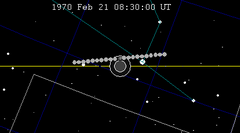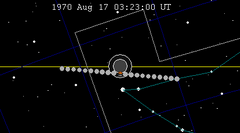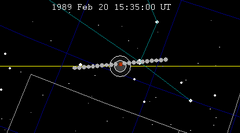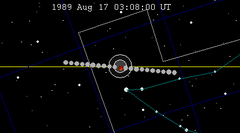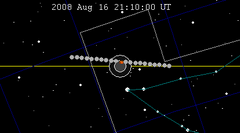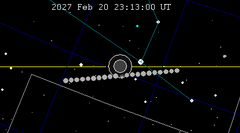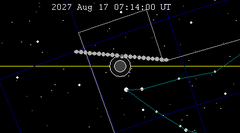
A partial lunar eclipse took place on 16 August 2008, the second of two lunar eclipses in 2008, with the first being a total eclipse on 20 February 2008. The next lunar eclipse was a penumbral eclipse occurring on 9 February 2009, while the next total lunar eclipse occurred on 21 December 2010.

A penumbral lunar eclipse took place on Thursday, 18 August 2016. It was the second of three lunar eclipses in 2016. This was 3.7 days before the Moon reached perigee. There are multiple ways to determine the boundaries of Earth's shadow, so this was a miss according to some sources. The HM National Almanac Office's online canon of eclipses lists this event as the last eclipse on Saros Series 109, while NASA lists August 8, 1998 as the last eclipse of the series, and has this event missing the shadow.
A penumbral lunar eclipse took place on Thursday, March 3, 1988, the first of two lunar eclipses in 1988, the second being on August 27, 1988. Earlier sources compute this as a 0.3% partial eclipse lasting under 14 minutes, and newest calculations list it as a penumbral eclipse that never enters the umbral shadow. In a rare total penumbral eclipse, the entire Moon was partially shaded by the Earth, and the shading across the Moon should have been quite visible at maximum eclipse. The penumbral phase lasted for 4 hours, 53 minutes and 50.6 seconds in all, though for most of it, the eclipse was extremely difficult or impossible to see. The Moon was 2.2 days after apogee, making it 6.1% smaller than average.
A penumbral lunar eclipse took place on Thursday, November 8, 1984, the last of three lunar eclipses in 1984. This subtle penumbral eclipse may have been visible to a skilled observer at maximum eclipse. 90% of the Moon's disc was partially shaded by the Earth, which caused a gentle shadow gradient across its disc at maximum; the eclipse as a whole lasted 4 hours and 28 minutes.
A penumbral lunar eclipse took place on Tuesday, May 15, 1984, the first of three lunar eclipses in 1984. This was a deep penumbral eclipse, with the southern limb of the Moon close to the Earth's shadow.

A penumbral lunar eclipse occurred on Friday, 5 May 2023, the first of two lunar eclipses in 2023. The moon's apparent diameter was 0.1% larger than average because it occurred 5.5 days before perigee. This was the deepest penumbral eclipse since February 2017 and until September 2042.

A partial lunar eclipse will take place on Friday 28 August 2026. The moon will be almost be inside the umbra, but not quite be contained within the umbral shadow at greatest eclipse.

A penumbral lunar eclipse will take place on 20–21 February 2027.

A penumbral lunar eclipse will take place on Tuesday, August 17, 2027. It will cause a subtle dimming as 54.56% of the Moon will cross within Earth's penumbral shadow.
A partial lunar eclipse will take place on May 16, 2041.
A partial lunar eclipse will take place on November 8, 2041.

A penumbral lunar eclipse will take place on October 28, 2042, according to some sources. This will be 0.4 days after the Moon reached perigee. This event marks the beginning of lunar saros cycle 156 according to some sources, and will be visually imperceptible and other sources have this as a miss.
A partial lunar eclipse took place on Monday, August 17, 1970, the second of two lunar eclipses in 1970, the first was on February 21 of that year. The Earth's shadow on the Moon was clearly visible in this eclipse, with 41% of the Moon in shadow; the partial eclipse lasted for 2 hours and 11 minutes. It was the second of two lunar eclipses in 1970.

A total lunar eclipse took place on Monday, April 24, 1967, the first of two total lunar eclipses in 1967, the second being on October 18, 1967.

A penumbral lunar eclipse took place on August 17, 1951. The northern edges of the moon entered the southern edge of the earth's penumbral shadow, leading to visually minimal dimming.

A penumbral lunar eclipse will take place on March 3, 2045.

A total lunar eclipse will take place on September 7, 2044. It will be the first total eclipse in Lunar Saros 138.

A total lunar eclipse will take place on March 13, 2044.
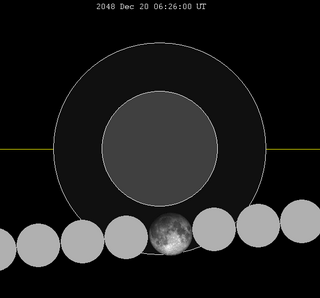
A penumbral lunar eclipse will take place on December 20, 2048.

A total lunar eclipse will take place on May 6, 2050.






















